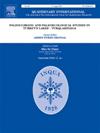Burnt Cervidae bones and sedimentary environments at Luotuodun, Jiangsu Province, China: New insights for Neolithic human behavior
IF 1.9
3区 地球科学
Q3 GEOGRAPHY, PHYSICAL
引用次数: 0
Abstract
The Luotuodun archaeological site is located in Yixing City, Jiangsu Province, in the transition zone from the Yili Mountains to the coastal plain. It is of Neolithic Age and dates from approximately 7000 to 5000 years ago. A large number of animal skeleton fossils have been unearthed at the site, many of which, especially those belonging to species of Cervidae (possibly Sika, Cervis nippon), are characterized by the presence of black residue on the surface. There are three types of residue, one is black film-like coating, which is suggestive of exposure to fire, one is also black, but crystalline in nature, while the other is grey-white, particulate deposit. With the aim of exploring the nature of these residues and their possible origins, we applied a number of analytical techniques, including Raman Spectroscopy (RS), Fourier Transform Infrared Spectroscopy (FTIR), Energy dispersive spectroscopy (EDS) and Electron Microscopy (EM) on six bone fossils belonging to different parts of Cervidae skeleton unearthed from Luotuodun to evaluate the possible influence of fire and/or depositional processes in their formation. The black film-like coating, widespread on the surface of these bones, is highly reflective and appears white under the Raman microscope. The RS peak indicates that the film-like substance is rich in carbonaceous (graphitic carbon) components, suggesting that the bones have been exposed to combustion. FTIR measurements on these bones show that the structure of hydroxyapatite carbonate (Ca10(PO4)6−x(CO3)x(OH)2) has changed, consistent with their exposure to very high temperatures (500–600 °C), and implying that they were burnt, either for cooking or ritual behavior by ancient humans. In the case of the crystallized black particles, these are primarily confined to localities on the surface of bone fractures. EDS results, as confirmed by the RS analysis, show that the black crystals are comprised of an iron-rich, phosphatic mineral, compatible with vivianite (Fe3(PO4)2·(H2O)8). The substantial vivianite content is consistent with the fossil bones being submerged and deposited in waterlogged soils. The results of EDS show that the composition of the grey-white particle is hydroxyapatite carbonate (Ca10(PO4)6−x(CO3)x(OH)2). Non-destructive geochemical analysis of the surface residues of these Luotuodan bones provides valuable evidence for reconstructing the taphonomy of the Cervidae bones, and reveals that they were utilized by ancient humans during the Luotuodun culture period in SE China.
江苏骆驼墩烧焦的鹿科骨骼与沉积环境:对新石器时代人类行为的新认识
骆驼墩考古遗址位于江苏省宜兴市,位于伊犁山与沿海平原的过渡地带。它是新石器时代的,大约可以追溯到7000到5000年前。该遗址出土了大量的动物骨骼化石,其中许多化石,特别是那些属于鹿科(可能是Sika, Cervis nippon)的物种,其特征是表面存在黑色残留物。有三种类型的残留物,一种是黑色的薄膜状涂层,这表明暴露在火中,一种也是黑色的,但本质上是结晶的,而另一种是灰白色的颗粒沉积物。为了探索这些残留物的性质及其可能的来源,我们应用了拉曼光谱(RS)、傅里叶变换红外光谱(FTIR)、能量色散光谱(EDS)和电子显微镜(EM)等多种分析技术,对六具属于洛脱屯鹿科骨骼不同部位的骨化石进行了分析,以评估火灾和/或沉积过程对其形成的可能影响。这种黑色薄膜状涂层广泛分布在骨骼表面,具有很强的反射率,在拉曼显微镜下呈白色。RS峰表明,这种薄膜状物质富含碳质(石墨碳)成分,表明骨骼已经暴露于燃烧。对这些骨头的FTIR测量显示,羟基磷灰石碳酸(Ca10(PO4)6−x(CO3)x(OH)2)的结构发生了变化,这与它们暴露于非常高的温度(500-600°C)相一致,这意味着它们被烧了,要么是为了烹饪,要么是古代人类的仪式行为。在结晶黑色颗粒的情况下,这些主要局限于骨折表面的局部。EDS结果与RS分析结果一致,表明黑色晶体由富铁磷矿物(Fe3(PO4)2·(H2O)8)组成。大量的橄榄石含量与化石骨头被淹没并沉积在浸水土壤中相一致。能谱分析结果表明,灰白色颗粒的组成为碳酸羟基磷灰石(Ca10(PO4)6−x(CO3)x(OH)2)。对这些骆驼墩骨的表面残留物进行无损地球化学分析,为重建鹿科骨的分类学提供了有价值的证据,揭示了它们在中国东南部骆驼墩文化时期被古人类利用。
本文章由计算机程序翻译,如有差异,请以英文原文为准。
求助全文
约1分钟内获得全文
求助全文
来源期刊

Quaternary International
地学-地球科学综合
CiteScore
5.60
自引率
4.50%
发文量
336
审稿时长
3 months
期刊介绍:
Quaternary International is the official journal of the International Union for Quaternary Research. The objectives are to publish a high quality scientific journal under the auspices of the premier Quaternary association that reflects the interdisciplinary nature of INQUA and records recent advances in Quaternary science that appeal to a wide audience.
This series will encompass all the full spectrum of the physical and natural sciences that are commonly employed in solving Quaternary problems. The policy is to publish peer refereed collected research papers from symposia, workshops and meetings sponsored by INQUA. In addition, other organizations may request publication of their collected works pertaining to the Quaternary.
 求助内容:
求助内容: 应助结果提醒方式:
应助结果提醒方式:


